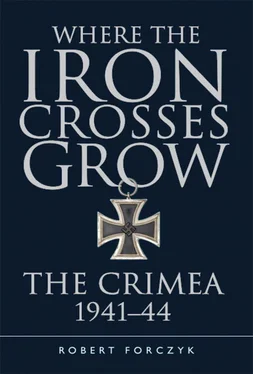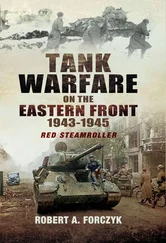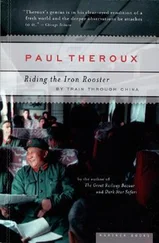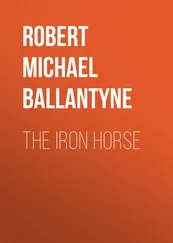Soon, the army commander [Kreizer] went with me to the south bank of the Sivash in order to get acquainted with the situation in the bridgehead. Here the picture was quite bleak. There was not a tree or bush… Around us stretched a boundless steppe as flat as a table and a drained white expanse of shallow salt lakes. There were not even any weeds visible. Only here and there was a sparse tuft of reddish-gray sage. We could see all the way to the horizon. It seemed that the troops were completely open to enemy observation and fire. To the south of our front line the enemy was located on ancient Scythian burial mounds … and our scouts have repeatedly noticed the gleaming glass of binoculars. Nor were there any sources of fresh water in the bridghead. [23] Peter K. Koshevoi, V gody voennye [ During the War ] (Moscow: Military Publishing, 1978).
The Germans were indeed watching and listening. German radio intercepts enabled Jaenecke to keep up with Soviet developments. He knew that Koshevoi’s 63rd Rifle Corps had reinforced the 10th Rifle Corps in the Sivash lodgment and that Petrov’s Coastal Army near Kerch was reinforced to eight rifle divisions and two tank brigades, with 75,000 troops and 80 tanks. [24] Ic, Anlage 4 z. Tätigkeitsbericht, January 1–March 31, 1944, AOK 17, NAM (National Archives Microfilm), Series T-312, Roll 748.
Jaenecke did succeed in rebuilding AOK 17’s units to some extent, although the overall balance was now so unfavorable that even full-strength units would have difficulty holding the Crimea. One of his efforts to create more effective combat units was the authorization of Gebirgs-Jäger-Regiment Krim (GJRK) in late March 1944; this three-battalion unit was formed under Major Walter Kopp from FEB 94 and FEB 125, plus remnants of the 4. Gebirgs-Division stranded in the Crimea. [25] la, Anlage 5 z. KTB Nr. 9, Besondere Vorgange, January 1–March 31, 1944, AOK 17, NAM (National Archives Microfilm), Series T-312, Roll 747.
Kopp’s regiment was assigned to Allmendinger’s V Armeekorps to provide it a real reserve, in case of more Soviet landings on the coast.
German intelligence estimates believed it was possible that the Soviets would attempt more amphibious landings on the Crimean coast when spring came, but concluded that the most dangerous threat was a breakout attack from their Sivash bridgehead, followed by an outflanking maneuver against the Perekop position. Although a German retreat to Ishun might have reduced this threat, Hitler refused to authorize any more withdrdawals in the Crimea. Instead, Jaenecke’s staff used the winter to begin work on a fallback position known as the Gneisenau Line, to protect the approaches to Sevastopol in case of a Soviet breakout from the Sivash, but this effort received little priority. By spring 1944, the Gneisenau Line consisted of seven company-size Stützpunkt , each armed with a few antitank guns and Romanian howitzers – at best, a delaying position. [26] Ia, Sonderband Nr. 4, z. KTB Nr. 9, Unternehmen “Gneisenau,” January 8–March 23, 1944, AOK 17, NAM (National Archives Microfilm), Series T-312, March 1944, Roll 746.
Jaenecke and his chief of staff, Generalmajor Wolfdietrich Ritter von Xylander, also worked on a variety of evacuation schemes, renamed first Litzmann , then Rudderboot , then Gleiterboot , then Adler . [27] Ia, Sonderband Nr. 5, z. KTB Nr. 9, Unternehmen “Litzmann,” November 13–24, 1943, AOK 17, NAM (National Archives Microfilm), Series T-312, Roll 746.
All these plans were designed to organize an emergency Dunkirk-style evacuation from the Crimea once an all-out Soviet offensive began in order to save as much of AOK 17 as possible, but they remained little more than staff studies since Hitler would not authorize an evacuation. Holding the Crimea was more important to him than the risk to AOK 17.
CHAPTER 9
German Defeat in the Crimea, 1944
“History shows that there are no invincible armies.”
Josef Stalin
Once spring weather arrived, the German goose in the Crimea was pretty well cooked. Tolbukhin and Eremenko had met with Stalin in Moscow during March to discuss the Crimea, and the basic plan of attack had been decided. Zakharov’s 2nd Guards Army would mount a strong deliberate offensive against Gruppe Konrad’s defenses at Perekop, while Kreizer’s 51st Army would stage a breakout attack from its Sivash bridgehead. Once the German front was broken, Vasil’ev’s 19th Tank Corps would exploit southward to Simferopol. Eremenko’s Coastal Army was intended merely to fix Allmendinger’s V Armeekorps at Kerch during the first phase of the Crimean Offensive and then exploit the situation as circumstances permitted. [1] Anatoly N. Grylev, Dnipro-Karpaty-Krym: Osvobozhdenie pravoberezhnoi ukrainy i kryma v 1944 gody [ Dnepr-Carpathians-Crimea: The Liberation of the Right Bank of Ukraine and Crimea, 1944 ] (Moscow: Nauka, 1970).
Compared to previous Soviet offensives, the 1944 Crimean Offensive was very well planned and coordinated. Zakharov’s troops had spent the winter months training intensively on breach operations, and were well provided with wire cutters, sapper platoons, and plenty of support weapons. On the Perekop front, the 2nd Guards Army had been busy digging approach trenches, which narrowed the width of no man’s land from 700–1,000 yards to just 150–200 yards. From their trenches, the Germans watched apprehensively as the distance narrowed.
Gruppe Konrad had prepared a defense in depth, consisting of three lines across the Perekop Isthmus. Indeed, this was a luxury that the Germans rarely enjoyed on the Eastern Front, but here the narrowness of the isthmus allowed them to concentrate their forces. Sixt’s 50. Infanterie-Division deployed in a standard “two up, one back” style, with Grenadier-Regiments 121 and 122 still holding the eastern and western ends of the Tatar Ditch, and the town of Armyansk in the center turned into a fortified Stützpunkt . Further back, two batteries of StuG III assault guns from Major Gerhard Hoppe’s Sturmgeschütz-Brigade 279 waited in reserve. Sixt’s other regiment, Grenadier-Regiment 123, was positioned even further back, where it could either reinforce at Armyansk or act as a reserve for the defenses on the Sivash. Oberstleutnant Willy Marienfeld, the former schoolteacher who was awarded the Ritterkreuz for being one of the first German officers into Sevastopol in 1942, was commander of Grenadier-Regiment 123. Hauptmann Walter Salzmann, another veteran company commander and Ritterkreuz recipient from the 1942 campaign in the Crimea, commanded Füsilier-Bataillon 50. Sixt’s division might have been badly depleted from losses, but it still had very capable tactical leaders. The German front line consisted of a continuous row of trenches, surmounted by rows of barbed wire and antipersonnel mines – reminiscent of the last year of World War I. The second and third lines of defenses were built at Ishun, but manned only by Romanian troops. The Axis defenses on the Sivash front were broken into three distinct groups by the lake terrain: a western group (consisting of the Romanian 38th Infantry Regiment), a central group (the Romanian 23rd and 33rd Infantry Regiments, the German 336. Pionier Bataillon, and a battery of StuG III assault guns), and an eastern group (the Romanian 94th and 96th Infantry Regiments, supported by two StuG IIIs). In all these sectors, the terrain was flat and constricted by water, which favored the defense.
Tolbukhin knew that airpower would be the crucial element of this operation, and he wanted to take the Luftwaffe out of the battle as quickly as possible. Hoping for a knockout blow, Tolbukhin decided to begin his Crimean offensive with a massive air attack by 8th Air Army on April 7 against the Luftwaffe bases and German artillery positions on the Perekop. Having learned the value of a specialist close-air-support unit from Fliegerkorps VIII, the 8th Air Army was provided with General-Major Vasiliy Filin’s 7th Ground Attack Aviation Korps (7 ShAK), which possessed 108 Il-2 Sturmoviks. Barkhorn was away on leave at the start of the Soviet offensive and II./JG 52 was apparently caught off guard by the scale of the Soviet onslaught; it got only a few fighters in the air in time. Protected by dozens of Yak-7 fighters, groups of Soviet Sturmoviks came in low over the treeless Perekop Isthmus, shooting up artillery positions and anything else that was visible. Although the Germans claimed that flak inflicted heavy losses on the raiders, the VVS raids were not seriously disrupted. [2] Christer Bergström, Bagration to Berlin: The Final Air Battles in the East, 1944–1945 (Hersham, UK: Ian Allan Publishing, 2008), p. 46.
Читать дальше












